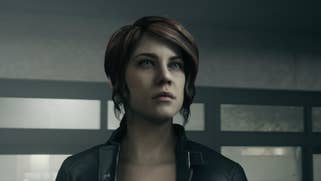Control on console is brilliant - as long as you play on the right hardware
Getting to the bottom of the game's reported frame-rate problems.
How well does Remedy's latest blockbuster, Control, stack up on consoles? Let's make no bones about it - the game is brilliant and a stunning technological showcase. It works on the Sony and Microsoft boxes, but the game reaches another level on PC, with Control featuring one of the most impressive DXR ray tracing implementations we've seen. In marketing the game, Remedy and publisher 505 have pushed PC to the forefront, to the extent where not much was seen of the console versions prior to launch. Our verdict so far? The game is worth checking out but there are performance issues and some of them can be show-stopping, depending on the hardware you're gaming on.
Perhaps this was inevitable bearing in mind the scale of ambition seen in this game. Remedy's Northlight engine has evolved considerably since the debut of Quantum Break three years ago. The game has a very specific aesthetic, built around beautiful global illumination and a physically-based rendering pipeline that adds a stunning level of realism and precision to the way materials interact with the lighting. Reflections move a step beyond the solution featured in Quantum Break to signed distance fields, a form of ray tracing seen before on console in titles such as The Tomorrow Children and Claybook - and here it's used to generate rough reflections used in conjunction with screen-space reflections.
The game's visuals are augmented by a ramped up version of Remedy's animation engine, with Control's physics and particle effects delivering some astonishing action. All items behave independently, and the sheer amount of them in any given scene creates scenes of unparalleled destruction. It seems that even the least important elements in any given scene can be individually dismantled, right down to single drawers in any given desk. It's the attention to detail here that really impresses - smash a glass window and the individual slats of the blind behind it react realistically. What we have here is astonishing attention to detail on the smaller scale stuff, all kicking off within the grander destruction of the overall scene.
The good news is that all console versions of Control essentially deliver the exact same visual feature set, the only real exception we could find being an adjustment to the shadow rendering solution on the base Xbox One. It looks different, but can hardly be described as a lower quality implementation. Beyond that, everything seems to be locked for each system - but of course, there are variations in pixel counts and frame-rates.
Similar to Quantum Break, the vanilla Xbox One uses a base 720p resolution with a temporal accumulation technique that gives the impression of a much cleaner image. Again, like Remedy's previous game, it does tend to lose fidelity in motion, but the overall look is good. The same trick is used on all other versions, just with adjustments to the base resolution. The vanilla PlayStation 4 gets a bump to 900p, rising to 1080p on PlayStation 4 Pro. Perhaps not surprisingly, Xbox One X sits at the top of the pile, with 1440p looking like a fairly close approximation to a 4K image thanks to the temporal super-sampling technique in play. Some aspects of the presentation - like the omni-present film grain - are tied to base resolution, so the progression in resolution across the console stack is fairly easy to notice.
Control is still a good-looking game on all systems, and it's actually the game's performance that is the primary issue here, to the point where we strongly recommend playing on the enhanced consoles and checking out our performance numbers closely before considering play on either the standard Xbox One or indeed the base PlayStation 4. To begin with, Control flatters to deceive and the first hour of the game plays out quite smoothly on the consoles.
However, as you press further into the game, the more you'll start to notice some serious slow-down. In our performance video, we choose a shoot-out in an Atrium and a battle in a power plant to draw some comparisons. Best of the bunch is clearly Xbox One X. It's by far the smoothest experience overall, but hitching and stuttering still interupt the flow of the game. It's mildly off-putting, but not a major issue. This is followed by the PS4 Pro. It's nowhere near as consistent as the X build, but it's a night and day improvement over the problematic base consoles.
















Both PlayStation 4 and Xbox One can see prolonged frame-rate drops in sustained combat, dropping all the way down to 10 frames per second at its absolute worst. Perhaps surprisingly, it's the PS4 that drops hardest and longest, making it noticeably the least performant version of the game. It ran so poorly that we ran through a range of checks, from rebooting the console completely to running Control on other PS4 units (the fan kicking in hard on a launch model). Nothing helped - this is how the game actually plays and it's not pretty. Xbox One S is better, there's no doubt about it, but it's still a highly unsatisfactory experience overall - a notch above PS4 in troublesome combat but still a game it's hard to recommend. The bottom line? Xbox One X delivers by far and away the best console experience on all counts, but the PS4 Pro is a decent enough runner-up.
Beyond frame-rate, there are some further issues that could use further tweaking if possible. First of all, the game's loading systems aren't quite as optimal as we'd like. On Xbox One S, I encountered stuttering and momentary freezing during video playback, while small hitches during UI navigation do point to an IO issue of some kind. More problematic are the loading times and texture pop-in. Control does a reasonable job of streaming in world data as you play but you'll notice textures drawing in at points. Most of the world feels relatively seamless save for short pauses when moving between major sections. Unfortunately, the most significant issue here lies in the obstrusive loading after you die - think Bloodborne and you'll have some idea of what I'm talking about here.
Overall, I do think Control is worth checking out - especially so if you're on PS4 Pro or Xbox One X - as it's absolutely fascinating from a design perspective. I'm not just talking abot the visuals as such (though they are unique in many ways) but more in how the game doesn't hold your hand. Yes, you're given objectives to achieve, but there's no on-screen pointer telling you where to go. It's down to you to survey the environment and generally be more observant than you need to be in the usual triple-A title. It's the way games used to be, and the way I like them. Combine that with the state-of-the-art visuals and the brilliant combat and Control simply has to be played - but it's PC or the enhanced consoles that play the game best. Right now, the base PS4 and Xbox One versions do need work in getting them into shape.






.jpg?width=291&height=164&fit=crop&quality=80&format=jpg&auto=webp)










